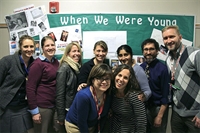How effectively are we communicating with our middle school students?
As a middle school counselor, I often step back and think: Am I speaking to fill the space? Is what I am saying applicable.
Most important, do I have a relationship with the people in this room?
Working with middle school students has its own unique set of challenges. By its very nature, adolescence is difficult—the brain is trying to catch up with the body, the heart with the mind, and the child with the adult. And in the midst of this chaos, we try to educate these young beings on how to solve for x, memorize the Constitution, dissect an owl pellet, and prepare to be successful students in high school and college.
How do we go about feeding the mind while supporting the soul? How do counselors communicate effectively with the people in the room who have the greatest impact on students, the ones who lead, and shape, and teach them? How do teachers and counselors communicate with students in a meaningful way that goes beyond checking the box on the Common Core curriculum matrix?
Failure to Launch
Research suggests that students don’t retain knowledge when the learning environment is stressful. While we may not view the typical classroom as a stressful environment, the brain may have a different opinion.
In her MiddleWeb article “How to Build Happy Brains,” Judy Willis discusses how adolescent brains are drastically different from adult brains in the way they take in, process, and retain information. Given the heightened emotional state of an adolescent brain, even the smallest amount of stress can get in the way of retention or engagement.
We must establish supportive relationships before we can expect students to truly thrive.

Teachers and counselors at Peak to Peak Charter School nurture relationships with students by sharing a bit of their own adolescence.
As the school leadership team at Peak to Peak Charter School in Lafayette, Colorado, began digging into the results of our student climate survey, we noted unfavorable responses in areas where we thought we were hitting the mark. Our students consistently reported low satisfaction with their relationships with teachers and with their comfort level in school.
While reviewing the results of our internal survey, I realized our intention was all right and our focus was all wrong. As leaders inside the classroom, we focus on how students are doing academically. We ask where the homework assignments are, how we can help students achieve better grades, and when the class project will be done. However, our students are not hearing how much we care about them as people. What they hear is that we are concerned about the grade on the test and not the person who is completing the task.
In focusing our efforts on academics, we were actually impeding our students’ success in school. We cared for our students, but because we demonstrated that concern through an academic filter, students were not thriving as they should have been.
Our failure to launch our relationships with these students was due in large part to our failure to lunch with our kids. We were squandering the opportunities to really get to know them, to have fun and enjoy them, and learn from them as human beings.
Unfortunately, in this world of increased focus on achievement and grades, on standardized test scores and college acceptance notices, it is difficult to find the time for relationships. So I set out to find a way to infuse relationship building into the classroom in authentic, effective ways.
A Quest for a Common Language
After my “aha” moment, I went on a mission. I opened a dialog with the teachers—a dialog I have nurtured for the past year and a half. The teachers are on the front lines; they are the ones leading these students to success. I want to help ensure all their hard work and efforts are focused in the right direction and that students are getting the message that teachers do care.
When I work with teachers now, my focus is on how to speak the students’ language in the classroom while maintaining focus on academics and balance for the good of the class. This may look different for each class they teach as each group forms its own synergy with its own set of unique needs. I concentrate on finding ways to infuse best communication practices into daily classroom interactions.
So what is different? What has changed with our communication style? I would like to think we are starting to speak the same language as our students. Instead of teaching academics from bell to bell, a teacher might scrap a lesson’s introduction and ask about everyone’s weekend, or what the best part of lunch was.
We have created ways to be playful and connect with kids. Teachers now infuse gratitude exercise into their classrooms. These types of exercises can be as simple as creating a gratitude box and asking students to share what they are thankful for and to whom in the class they would like to pay gratitude. Teachers have days when they share the contents of the box with the class and allow students to express their appreciation of each other.
We now have a bulletin board where teachers and counselors proudly display their own stories from adolescence. We include questions, answers, and pictures of this ever-awkward time in our lives. This helps students connect with us on a more authentic level and view us as part of their village, as people on a journey right along with them. Students often stop in the hall to study the familiar faces of their teachers depicted in a time that they can connect with on a personal level. This helps them realize that their teachers were once just like them; their teachers can relate to the peaks and valleys of growing up.
Recently, I asked students to document with honesty how it really feels to be in the classroom and to shed light on how they view us. I will use these narratives in a reflection exercise with teachers in hopes that it will give us a glimpse of what are our students are experiencing and how we can shift and grow.
Leading by Example
The results feel good. We are communicating that we care and that we are committed to lead by example. We have not asked students to do as we say and not as we do. We are working to exemplify good character in action.
It is no surprise that our relationships are getting stronger and our culture is thriving. The students who have historically struggled are now achieving. They want us to know they are putting in an effort. They want us to know they care because they know we care.
As educators, we need to get into the heart of what matters to our students. If we understand what matters to them, we allow them space to thrive in an environment where they feel welcomed, safe, accepted, and valued.
Andrea M. Salvo is a middle school counselor at Peak to Peak Charter School in Lafayette, Colorado. andrea.salvo@bvsd.org
